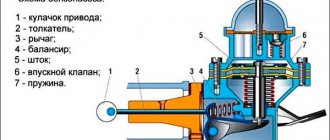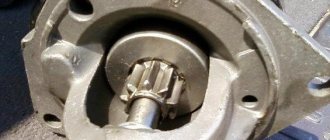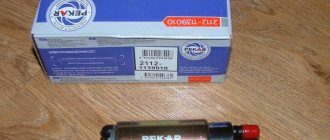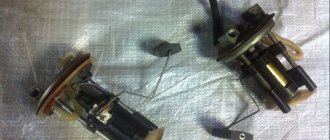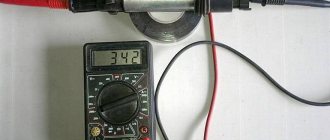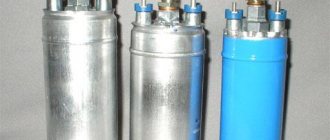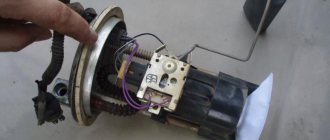Modern passenger cars are equipped with electric vibration pumps. Unlike mechanical predecessors, installed near the engine, the new units are immersed inside the gasoline tank, where direct access is limited. In order to independently solve problems associated with interruptions in the fuel supply, you need to be able to distinguish the signs of a fuel pump malfunction from problems with other elements of the fuel system.
Gasoline supply problems - common symptoms
Malfunctions of the fuel supply system are conventionally divided into 2 categories:
- The combustible mixture is not supplied to the cylinders at all.
- Gasoline is supplied intermittently or under insufficient pressure.
In the first case, the engine does not start and does not engage the starter during rotation, that is, it does not show signs of life. In such a situation, it is always easier to determine the cause of the breakdown.
When insufficient fuel enters the cylinders, the following symptoms appear:
- starting the power unit “from cold” is very difficult, the engine seizes and “sneezes”, it starts in 3–10 attempts;
- idling is unstable, the engine “troubles”;
- dynamic acceleration becomes impossible - a sharp opening of the throttle causes a long dip and deceleration;
- when the driver releases the accelerator pedal, the engine often stalls;
- The car has difficulty climbing hills and accelerates slowly when fully loaded.
The cause of the above phenomena may be a malfunction of the fuel pump or other elements of the system, and the primary symptoms are almost the same. To carry out an accurate diagnosis, you need to understand how the car's power system works.
Design and operation of fuel supply
The system that provides the engine with the required amount of gasoline operates according to the following algorithm:
- After turning on the ignition, the electric fuel pump starts, raising the pressure in the line after itself to a certain level. The electrical power supply circuit of the unit is protected by a fuse.
- The fuel pressure regulator (common abbreviation - RDT) is located on the line after the pump and limits the upper pressure threshold, dumping excess fuel back into the tank through a separate pipeline.
- When the crankshaft is rotated by the starter and the engine continues to operate, fuel enters the fuel rail, mixes with air and is directed to the injectors built into each cylinder. The amount of mixture supplied to the combustion chambers is controlled by an electronic unit.
- On the way to the fuel rail, gasoline goes through 2 stages of filtration. The first is a mesh installed in the tank on the suction pipe of the pump, the second is a fine filter on the gas supply line.
Reference. In various car models, 2 schemes are used for installing the RTD and laying the return pipeline - in the engine compartment or directly in the gas tank. In the first case, the standard fuel pressure in the system is 2.7...3.0 Bar, in the second - 3.8...4 Bar.
A common mistake made by ignorant car enthusiasts: if the combustible mixture does not enter the cylinders, then the fuel pump is definitely not working. Knowing the design of the fuel supply, we can assume other problems:
- the protective fuse in the electrical circuit has blown, the pump is in good working order, but does not receive power;
- the primary or secondary filter is clogged (sometimes both at once), fuel flows in small quantities or does not flow at all;
- the pressure regulator has become unusable, dumping the lion's share of the fuel back into the tank, the engine gets nothing;
- One or more injectors have failed.
To accurately determine the source of the problem, you need to check the operation of the electric fuel pump and other elements. It is not necessary to go to a service station - diagnostic work can be carried out in your own garage.
How to check the functionality of the pump?
If the engine is absolutely “dead”, follow this algorithm:
- Turn on the ignition without turning the starter. A working electric fuel pump should respond with a quiet but distinct buzzing sound coming from the rear row of seats. If there is no sound, go to the next step.
- Using the car's operating instructions, find the number of the fuse that protects the pump's power circuit. Try replacing it; if unsuccessful, check the wiring and clean the contacts from oxides.
- If previous manipulations did not produce results, you need to measure the fuel pressure in the fuel rail.
Pressure measurement is also practiced when identifying symptoms of insufficient fuel supplied to the cylinders of the power unit.
To take measurements and compare signs of a breakdown with a fuel pump or other element, you need to reset the initial fuel pressure in the system, no matter how low it turns out to be.
If the pressure is below normal, proceed to find out the reasons according to the recommendations:
- There are pressure surges in the range of 0.2...0.3 Bar at idle - look for a problem in the filters. Surely the coarse mesh or secondary element is clogged.
- Use pliers to pinch the return line hose coming out of the RTD. The gasoline pressure should increase to 5 Bar, with the new pump - to 6 Bar. If the readings are 4 Bar or lower, the cause should be sought in the regulator or the pumping unit itself.
- The best way to identify a fuel pump malfunction is to exclude other parts of the system and take a measurement directly at the outlet fitting. If the pressure gauge shows 5 Bar, the unit is working properly and you need to change the RTD, which dumps half of the fuel into the tank.
To measure the pressure at the outlet of the electric fuel pump, you will need to remove the rear seat, dismantle the service hatch and connect a pressure gauge to the supply fitting of the unit. Here you may need adapters in the form of plastic clamps or threaded tubes.
Before changing the pressure regulator, make sure that the gas lines and filters are of normal capacity. Due to refueling with low-quality fuel, even the flow area of 8–10 mm tubes can become clogged. Then the pressure gauge on the ramp and pump will show different values, and the RTD will regularly drain excess fuel into the tank.
Similar symptoms not related to the fuel pump
The symptoms that appear due to a lack of fuel in the supply line are quite typical and are very similar to problems with other systems. How to eliminate possible problems using the elimination method:
- Unscrew and inspect the spark plug skirts. When there is not enough fuel, the electrodes remain clean or become covered with a white coating. This is further evidence of a malfunction in the power system.
- Replace spark plugs. If they wear out, they create a similar effect - failures, difficult starting, and a drop in engine power.
- Check the functionality of the throttle position sensor (TPS) and idle air control.
- Measure the compression in all engine cylinders. Due to excessive wear, the naturally aspirated engine is unable to create the required pressure and vacuum; the mixture burns poorly, which is why identical symptoms occur.
The principle of operation of the fuel pump
Schematic diagram of a fuel pump
The main function of a fuel pump is to transfer fuel from the tank to the engine. In injection engines, the fuel pump is connected to the fuel rail, and in carburetor engines - to the carburetor. In this case, it is necessary not only to pump fuel, but also to provide a certain pressure. Too high pressure leads to increased richness of the mixture and high fuel consumption. Too low pressure leads to a lean mixture and a drop in power. Both the first and second cases negatively affect the engine life. That is, the fact that the gas pump pumps fuel does not indicate its full serviceability.
What happened?
The performance range was from 67.1 to 146.7 l/h - more than double!
The lowest performance was found in an expensive pump costing 3,250 rubles. Let us remind you that we bought the cheapest one for only 900 rubles.
Details are in the final table.
Of all the results obtained, we consider the main ones to be the pressure regulator opening voltage, as well as the pump efficiency - the ratio of performance to power consumption. We recalculated these values into ratings on a five-point scale: more is better. Their arithmetic average allows us to judge the technical perfection of the pump.
The best were the Italian ERA Fuel pump and the Chinese Kortex KPF. It is curious that both were sold as “foreign” ones: the first for Mitsubishi, the second for Mazda.
But the worst in all respects was... Bosch.
The actual characteristics of the tested pumps are not proportional to the price tags, so in conclusion we calculated the price/quality ratio, also bringing it to a five-point rating system.
Surprisingly, the leader was not a frankly cheap pump, but... the same Italian EPA. Absolute victory!
When should you check your fuel pump?
It is necessary to check all potentially faulty components one by one, and the fuel pump first.
Problems when starting and running the engine are not always associated with the fuel pump. Sometimes the signs of a fuel pump breakdown are the same as those of a faulty fuel pressure regulator , injectors or jets, spark plugs and high-voltage wiring. Even experienced specialists who know by heart all the signs of a “dying” pump cannot unambiguously determine the type and cause of the breakdown the first time, and it is necessary to check all potentially faulty components one by one. In this case, the fuel pump is usually checked first. In this case, there are two types of malfunction - the fuel pump does not work at all or does not produce the required pressure. In the first case, the malfunction can be recognized by ear, since it should start when the ignition is turned on. In the second case, you need to know how to check the pressure of the fuel pump. Here you need to use a special pressure gauge. We list the main symptoms of a fuel pump malfunction:
- the engine does not start;
- the engine is unstable;
- the engine lacks traction during sharp acceleration;
- The engine lacks traction at low speeds.
Video on the topic
The fuel pump is one of the main components of a car. Without it, it is simply impossible to start the engine, much less operate it. Therefore, if you have any problems starting or operating the engine, you first need to check the fuel pump. To find out how to check a gas pump, you must first determine the basic principles of operation of this unit and possible breakdowns. As a rule, the fuel pump is not repaired and is replaced by a working one. However, it is necessary to identify that this is where the problem lies.
The main causes of fuel pump failure
The coarse filter is clogged
Old and new fuel pump coarse filter
A clogged filter is brown in color because its cells are completely clogged with sediment.
The most common problem that causes the fuel pump to not pump is a clogged coarse filter. This filter is usually installed in the tank immediately before supply to the pump itself. This is where primary fuel filtration occurs. This malfunction can be determined visually. A clogged filter is brown in color; the cells in its mesh are almost completely clogged with sediment. Even a working pump cannot pump fuel through such a filter; as a result, the required pressure is not provided in the system. The coarse filter must be replaced. Its cost is low (about 50 rubles). However, replacing it takes time and a set of tools. First you need to remove the fuel pump itself, which is usually screwed to the tank. Before removing the fuel pump, you need to disconnect the terminal on the battery. Then the fuel pump is removed and the filter is removed from it. The filter itself is installed on the pump manually, without tools. It is recommended to change the coarse filter every 20 thousand. However, it can become clogged much faster. This depends on the quality of the fuel and the condition of the fuel tank. It only takes one refuel with low-quality fuel at an untested gas station to clog the filter. It can also easily become clogged with rust if the tank is already old and susceptible to corrosion.
Incorrect operation
An electronic fuel pump can be installed in the engine compartment.
If there is a small amount of gasoline in the tank, the electronic fuel pump quickly overheats.
Unlike a mechanical pump, which is installed on carburetor engines, an electronic one can fail due to improper use. The electronic pump becomes very hot during operation. It is cooled by the fuel in the tank. Therefore, with a small amount of fuel, the pump may overheat. At the same time, short-term operation with a practically empty tank is not critical for the pump. If you constantly operate the car with an almost empty tank, the fuel pump will overheat and quickly break down. It is recommended to keep the tank at least one third full at all times. Especially often, the fuel pump breaks down due to overheating on cars with gas equipment. Here, gasoline is used only to start the car, then gas is used for operation. As a rule, owners of such cars keep a small amount of gasoline in the tank. In this case, the fuel pump constantly works to maintain a certain pressure in the fuel rail. If there are only a few liters of gasoline in the tank, the fuel pump quickly overheats.
Wear
The fuel pump contains rotating parts that are subject to friction. Over time they wear out. Therefore, if the fuel pump is making a loud noise, it is advisable to replace it. The operation of the fuel pump should not be heard from inside the car when the engine is running. A pump that is too worn can jam over time and stop pumping fuel. To find out how to replace the fuel pump, you need to look at your car's manual. In mechanical gasoline pumps, the membranes wear out quickly, especially if they are of poor quality. As a result, traction is lost and the engine runs unstable due to a lean mixture. Mechanical pumps especially often break down in the summer due to overheating. Therefore, an electric low-pressure fuel pump is often installed for the carburetor, which is connected to the fuel line, instead of a conventional mechanical one. This avoids problems in the summer when the mechanical pump stops pumping. In addition, the car's dynamics are improved, since the electric pump allows fuel to be supplied to the carburetor at constant pressure.
Fuel pump service life
- To the beginning of the forum
- Forum Rules
- Old design
- FAQ
- Search
- Users
The service life depends mainly on the quality and composition of the liquid, which is usually called gasoline.
The service life depends mainly on the quality and composition of the liquid, which is usually called gasoline.
You can predict the moment of death yourself when you take it out of the gas tank. I advise you to look at BN prices.
It takes about forty minutes to change it yourself. A mesh filter costs 50 rubles. This is instead of not hitting a thousand.
Well, an hour and a half. I watched as the men cut. So they dealt with the swearing in about thirty minutes.
Why do you always drive with the seats up?
Why do you always drive with the seats up?
It’s not that it’s dead for me, but soon it will be 80k and it’s scary for me to drive with the old one and installing a new one is choking me, suddenly this 20k goes away. I would like to know how it dies: once and that’s it, or it puffs and moves for several hundred kilometers, and in general, what are the statistics on pumps - how long do they last?
If you are driving far from civilization, then you should probably cut out the hatch, take out the BN and change the mesh, see how easy it is to change, and buy a new one, check it and put it in reserve. Or vice versa, put a new one and keep the old one as a reserve. Well, that is, of course, if you have money for a spare fuel tank. And it’s not difficult to change, nothing tricky.
It’s not that it’s dead for me, but soon it will be 80k and it’s scary for me to drive with the old one and installing a new one is choking me, suddenly this 20k goes away. I would like to know how it dies: once and that’s it, or it puffs and moves for several hundred kilometers, and in general, what are the statistics on pumps - how long do they last?
If you are driving far from civilization, then you should probably cut out the hatch, take out the BN and change the mesh, see how easy it is to change, and buy a new one, check it and put it in reserve. Or vice versa, put a new one and keep the old one as a reserve. Well, that is, of course, if you have money for a spare fuel tank. And it’s not difficult to change, nothing tricky.
Source of the article: https://autolada.ru/viewtopic.php?t=84525
What is a fuel pump and how it works
The purpose of the fuel pump is to supply fuel to the car engine from the fuel tank. Since the engine and gas tank are located on opposite sides of each other, fuel supply is impossible without a gas pump.
There are two types of fuel pumps: mechanical and electric. A mechanical fuel pump can be found in a carburetor type car. Fuel must be supplied to the carburetor at low pressure. Electric fuel pumps are specially designed for fuel systems with injection type fuel supply (injectors).
The mechanical fuel pump is attached to the outside of the fuel tank, and the electric one is attached to the inside. Some engines have two fuel pumps at once: one of them operates at large volumes and at low pressure inside the fuel tank, and the other operates at small volumes and at high pressure, located near or on the engine.
Mechanical fuel pumps suck fuel from the tank into the engine. The distance between the pump and the carburetor is small. Thanks to this they can work under low pressure. The operating principle of electric fuel pumps is based on pushing fuel into the engine. The operation of such a pump is controlled by the vehicle's electronic system.
This control takes into account throttle position, fuel/air ratio and exhaust gas content. Electric fuel pumps heat up quickly and make a lot of noise due to the fact that they operate under pressure. Because of this, they are placed in the fuel tank as it muffles the noise and cools the pump.
The fuel pump is started by an electric motor. After turning the ignition switch to switch on, a signal is sent from the on-board computer to start the fuel pump. An electric charge enters the fuel pump. The engine rotates for several seconds, during which time the necessary pressure is created in the fuel system. If a signal is not sent to the on-board computer within two seconds, the fuel pump automatically turns off.
If an emergency shutdown does not occur, fuel enters the fuel pump through a tube and exits through a one-way valve. Next, it enters the fuel filter, which traps particles of debris and dirt, and only after that the purified fuel enters the engine. The fuel pump stops working simultaneously with the engine.
Pressure is the most important parameter for a fuel pump, affecting the amount of fuel injected into the engine. The gearbox is responsible for the stability of the fuel supply.
Repair
Mechanical fuel pump repair
Repairing a mechanical fuel pump consists of installing a new repair kit (diaphragm and valves) and, if necessary, a worn pusher with a spring. A deeper repair of this device is impractical, since the costs of purchasing and repairing worn parts are close to the cost of a new product. If the pump housing is deformed or damaged, it must be completely replaced.
Electric fuel pump repair
The electric fuel pump is equipped with a non-separable housing, and if it breaks down, the product is replaced with a new one. Without special skills, equipment and spare parts, opening and repairing it is impossible. But some workshops undertake similar work, the price of which is lower than buying a new pump. The main failures of the device are as follows:
- Damage to brushes and motor commutator. Repair involves replacing them with new ones.
- Breakage of the plastic coupling connecting the rotor and the motor armature shaft. The clutch is replaced with a new one.
- Anchor failure. The repair involves rewinding this part.
The described actions allow us to eliminate the gas pump malfunction on all models of the VAZ: 2101, 2102, 2103, 2104, 2105, 2106, 2107, 2108, 2109, 21099, 2110, 2111, 2112, 2113, 2114, Niva, Priora, Kalina, Grant, Vesta and most foreign cars.
Signs of a fuel pump malfunction
Using these signs, you can determine that the fuel pump is not pumping.
- The most common sign of a faulty fuel pump is that the car drives intermittently. While driving, the car begins to sharply slow down and then accelerate. Uniform movement of the vehicle is ensured by a continuous supply of fuel.
- The second most common symptom is floating engine speed at idle. This way you can determine if the fuel pump is faulty before you start driving.
- The engine starts with difficulty or does not start at all. Quite often this happens because the fuel pump has completely failed. The symptom is not the most common, since the reason that the engine does not start may lie in a variety of malfunctions.
- The car's dynamics deteriorate. When you press the gas pedal all the way to the floor, the car jerks or does not respond at all to moving the pedal. In this case, the fault may lie not in the pedal, but in the fuel pump.
Do not forget that all the signs listed above are not one hundred percent. Such malfunctions can be caused by failure of various other engine parts. The engine speed may well fluctuate due to a malfunction of the mass air flow sensor or throttle position sensor.
Conclusion
Fuel pump problems are not easy to diagnose, especially because some symptoms are similar to those that occur in other systems. Additionally, problems with the sensor can interfere with the fuel system, making diagnosis difficult without some repair experience and specialized diagnostic tools. But this guide can help you solve some common problems you may encounter if you think your fuel pump has failed.
How do you like the article?
How to check the operation of the fuel pump?
First, you should check the fuse. To do this, check the instructions for its location. Next, you should check the voltage at the pump. Before doing this, be sure to check if everything is in order with the battery. The voltage at the fuel pump terminal must be checked using a multimeter or tester. The instruction manual always indicates the required voltage.
If the search does not yield results, then the voltage should be checked on the contacts themselves. All contacts must be in place and connected to ground. A broken contact or its oxidation leads to failure of the fuel pump system. If no broken contacts are detected, but the voltage drops by more than 1 volt, then the problem is in the wiring or oxidation of the contacts. There should be no short circuit in the wiring.
If, after checking the voltage, contacts and fuse, you do not find any problems, then the problem lies in the fuel pump itself. In this case, the fuel pump will most likely require replacement. In practice, it most often turns out that replacement is a last resort. First, you should try to restore and test the fuel pump again.
How to check the pressure in the fuel rail?
You will need a pressure gauge that measures pressure in the range from 7 to 10 atmospheres. If you choose a pressure gauge with a large margin, you risk getting less accurate measurement results. Specialized stores sell a kit for measuring pressure, but you can also design your own device.
If you want to assemble the device yourself, you will also need a hose with an internal diameter of 9 millimeters. You will also need plumbing tow, with which you can seal the connection between the pressure gauge and the tube. All parts are connected and tightened using a clamp. You will also need a car spool. Next you need to perform a series of actions:
- Place the car on a level surface that is prevented from rolling, turn off the ignition and open the hood.
- Check that the injection nozzles have access to the fuel rail.
- Find the fuel pressure plug and remove it. Then you should unscrew the nipple using the spool.
- Prepare an empty container (a regular bucket will do) and a clean rag. This is necessary to collect residual fuel, which under pressure can splash out in different directions. Therefore, take care of the safety of your skin (especially your face and eyes).
- Connect the device to the fitting and begin checking the mechanism.
Checking the pressure in the fuel rail should occur in four operating modes of the power unit:
- when the ignition is on;
- at idle engine speed;
- code the fuel pressure regulator tube is reset;
- when the drain tube is compressed.
Is the fuel pump dying? Just don’t buy an expensive one as a replacement!
The electric fuel pumps selected for examination are the most popular on our market. In terms of mounting dimensions and characteristics, they are suitable not only for Ladas, but also for many foreign cars - Ford, Opel, Mitsubishi, Mazda, Nissan models. Accordingly, the range offered to the buyer is so rich that making the right choice is not easy. But our examination should put everything in order.
We bought almost everything that is offered in offline stores and on the Internet. As a result, we have eight similar products sold as spare parts for Ladas or as foreign-made parts that are also suitable for Ladas. We remind you that the results we obtained relate to a specific sample of gasoline pumps and do not allow us to judge the products of a particular company as a whole.
